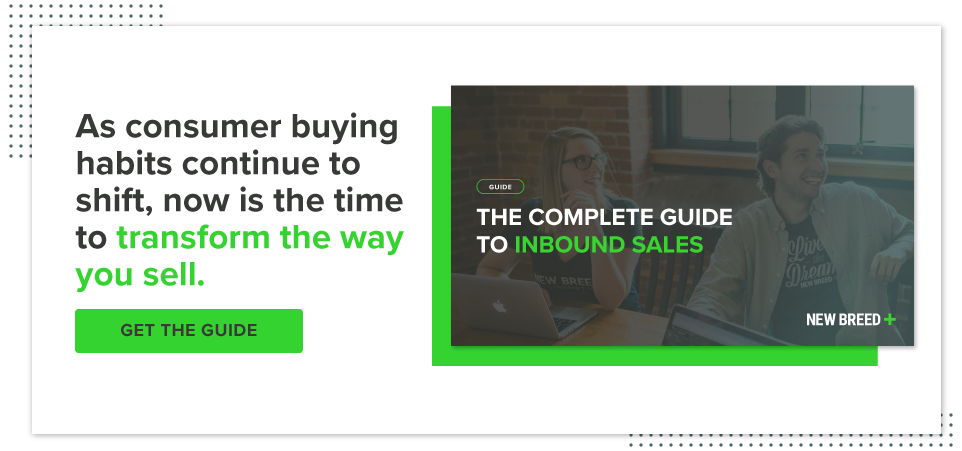10 Sales Tips from a Business Development Representative (BDR)

When it comes to sales, there isn’t a one-size-fits-all way to see success. You never want to become stagnant though. Sales is constantly changing, and so are buyers' habits. You have to be able to adapt and think on your feet.
A great way to keep growing as a sales rep is to expand upon the knowledge you already have, whether that’s reading books, working with others from your own company or just hearing what works best for other sales reps in any industry.
Because of that, I sat down with our own business development reps (BDRs), Ken Bourneuf and Finn Hopkins, to talk about their biggest tips for success in a BDR role and what they wish they had known when they first started in sales.
Here are 10 sales tips for BDR reps:
1. Be Creative
Sales is all about standing out, and the easiest or most convenient way may not always be the best way. You have to constantly be trying to get noticed among the other emails in someone's inbox and other callers who are selling the same product or service as you.
“A great example of how I get creative with outreach is that instead of leaving someone an email that tells them we offer website conversion optimization, I will record my own screen going through their website and show them how we would improve their site,” says Ken. “This way, my video stands out. They don’t have another boring email in their inbox, and I get to show them a bit about what we do in a personal way.”
Using your prospects’ actual website as examples is also a great way to show them how dedicated you are as a rep to solving for them specifically and that they aren’t just on the receiving end of a mass email you sent out.
2. Always Be Helpful
It’s easy to think of cold calling and knocking on doors when you think of sales. For a lot of people, that’s still how they see sales. Understanding some of the leads and prospects you are reaching out to have this perception will help you be a better salesperson. You can prove that perception wrong by immediately adding value for the person you are reaching out too.
“I always try to remember to be helpful and honest first,” says Ken. “Everything we are doing is to try to offer value to someone, and everything you do has to be rooted in that.”
Companies that leverage the inbound methodology should have plenty of content available that can help education prospects. This comes into play heavily when our BDRs do their first initial outreach.
“We read prospects' digital body language and send over recommendations or resources that are relevant to the pages they were viewing or topics they seem interested in,” says Finn.
A BDR should be trying to show a prospect the value they bring to the table before ever trying to get them to book a meeting or make a purchase.
3. Have an Extensive Toolbox
There are so many platforms and technologies out there for a sales rep to use right now. Leveraging your tech stack to best serve your prospects is key.
“I leverage tools like LinkedIn every day to do my due diligence on prospects before I reach out to them, and I use tools like Vidyard to customize my outreach,” says Finn. “Having a multitude of options in terms of technology and tools lets you decide which one will best help the prospect you are trying to reach in that moment”
Finn also says he stays on top of the conversational marketing tool, Drift, that we use on our website.
“It’s important as a sales rep that I make sure I’m seeing what leads are coming in through the bot on our site,” says Finn. “Timing is everything, and I never want to miss the moment to jump online and speak to someone when they are interacting with our chatbot or follow up with them shortly after to make sure they got everything they needed.
4. Meetings Links Are Your Friend
Our sales team uses HubSpot to do their daily outreach, and HubSpot gives each sales user the ability to have their own meetings link.
This helps overcome a large challenge all sales reps have: finding a time that works for both the rep and the prospect to meet. Meetings links help make asking someone for a meeting a bit smoother because saying something like, “Hey here’s my meetings link. Find a time that works for you!” takes some of the pressure off the situation through email.
“Being able to send people a link with a simple message to book time on my calendar is so helpful when trying to move to that next phase with a prospect,” says Ken. “You can even use shared meetings links so that you can have a prospect book time that works for both myself and an advisor who will also be on the call.”
5. Find a Balance of Personalization and Efficiency
“Using personalization tokens in your templates, using first names and having an understanding of what a company does before that first outreach are all really important things,” says Ken. “But at the end of the day, you are a BDR, and you have to stay focused on doing enough outreach to yield results.”
As a BDR you have to find a balance between personalizing outreach and getting enough outreach out the door. Sure, in an ideal world you would be able to spend hours on every single lead in your system but that just isn’t reality.
“Give attention to the leads that are hot and have the best chance to close,” says Finn. “Spend a little extra time to make sure they get the best outreach possible.”
6. Organize and Prioritize
“To really succeed in a BDR role, you have to be able to allocate your time effectively to those good fit leads that are actually engaging [with your company],” says Finn.
Sales is all about timing, and sometimes an hour or two could be the difference between successful outreach and unopened or unanswered emails.
Having your database and lead system structured to easily look at what prospects are engaging with, how often they are engaging as well as making sure you have lists and alerts set up to keep tabs on leads is key.
“It’s easy to want to treat all of your tasks with the same priority, but you just can’t do that in a BDR role,” says Finn. “You have to prioritize the hot leads and be willing to shift your whole day around when someone interacts either your email or calls you back if you want to see results.”
7. Don’t Get Discouraged
“You have to have thick skin to be in sales but especially in a BDR role,” says Ken. “You may get made fun or shut down in a harsh way, but you have to be able to brush it off and move on.”
BDR’s spend a ton of time crafting emails, making calls, leaving voicemails and sometimes even calling wrong or fake numbers. You do a lot of work upfront to get those few connections and that becomes your moment to shine. But it can be really tough to go unanswered or turned down.
“Know when to fold on a lead or contact as well,” says Finn. “Your ego can get in the way sometimes, but you have to be able to read when you just aren’t getting somewhere with a lead and it would be more beneficial to put your time and energy somewhere else and walk away.”
8. Be Flexible
If you aren’t able to be flexible then a BDR role may not be for you. If you like being able to layout your entire to-do list at 8 a.m. and slowly but steadily work your way through crossing off the list, you also may not succeed in a BDR role.
“When someone is looking at information, you don’t really have a say in timing,” says Ken. “That’s the moment that you have to jump, and sometimes it doesn’t matter what else you were working on or what you had planned for the next 30 minutes. You have to shift.”
Your prospects aren’t going to wait 24 hours for you to call them back. What they saw on your website five minutes ago may not even be relevant to them in the next hour. Timing is key, and since a BDR has to manage tons of leads and companies all at once, flexibility is also key.
9. Leverage Your Team
Most companies have their sales reps start out as BDR’s. This is because a BDR role gets you a ton of experience in a fast-paced and intense environment and is a great first step into sales.
Because of this, a lot of the sales reps at your company have probably either been in a BDR role there or worked in a role similar before.
“Leverage your teammates,” says Finn. “They are there to help and know what you are going through. I learn a ton from reading some of our senior reps’ emails and watching the way they go about dealing with prospects.”
Your teammates are there to help you, not bring you down. While being a BDR can feel sometimes like you are there to prove yourself, it doesn't mean you shouldn’t lean on your teammates or ask for pointers and tips.
10. Know What You Bring to the Table
BDRs are commonly perceived to be less knowledgeable than senior reps, and it’s not uncommon to get that type of feedback or inclination from prospects.
“Know your worth and that what you bring to the table is so valuable for prospects even before they get to that next level of speaking to a sales rep or advisor at your company,” says Ken.
Your teammates, whether fellow BDR’s or a next-level sales reps are all there for one purpose, and that’s to give each prospect the best experience possible that truly fits their needs.
“Even senior reps will loop in an inbound strategist or an SEO expert if the prospect needs that extra value or opinion to see the value in what you have to offer,” says Ken. “Be confident in your knowledge but don’t be afraid to loop in someone else if you need too.”
Weslee Clyde
Weslee Clyde is an inbound marketing strategist at New Breed. She is focused on generating results using inbound methods and is driven by the customer experience. When not at the office, you can find her binging a docu-series on true crime or perfecting her gluten-free baking skills.





